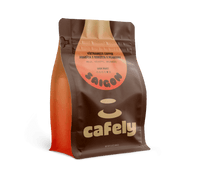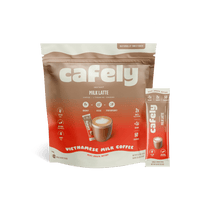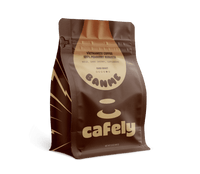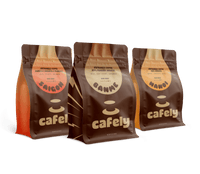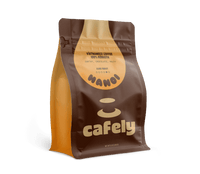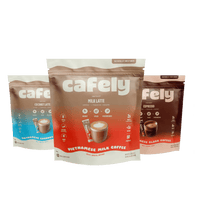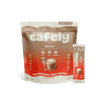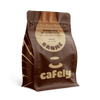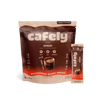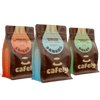For many coffee lovers, opening a coffee shop isn’t just a dream — it’s a passion project.
However, turning that dream into a thriving business takes more than just a love for great coffee.
Like any business venture, a coffee shop requires careful planning, realistic expectations, and a solid grasp of the numbers.
In this guide, we’ll break down the coffee shop industry, explore profit margins, and help you understand what it really takes to succeed in this business.
Is Owning a Coffee Shop Profitable?

Owning a coffee shop can be profitable, but it’s a lot more complex than a simple “yes or no” answer. The exact costs you’ll be paying out during the course of running your shop are liable to change, as are the prices you charge.
Outgoings: Monthly Costs
Running a coffee shop comes with recurring expenses — rent, staff wages, ingredients, and more.
Rent is often the biggest cost, especially in high-traffic areas. Lower-rent locations may shift the burden to higher staffing needs. Buying a property can save money long-term but requires a large upfront investment. Renting offers flexibility but comes with ongoing costs.
Startup expenses like equipment, seating, and decor can add up fast — but you can save by buying second-hand gear and doing some DIY work.
Staff wages are another major expense. Make sure you have enough cash flow to cover payroll, even during slow months — many cafes fail due to poor planning here.
Lastly, ingredient costs like coffee beans and milk are ongoing. Buying in bulk helps, but quality matters — shop around for the best supplier.
💡 Cafely wholesales! Fill out our wholesale form to request pricing and details for high-quality Vietnamese coffee.
Earnings: Monthly Income
Your coffee shop’s income depends on several revenue streams.
The primary source is daily sales — coffee, pastries, and light meals. While you can’t control customer choices, you can influence them with smart upsells like syrups, snacks, or lunch options.
Another strong opportunity is catering. If you make food and drinks in-house, you can offer bulk orders for offices or events — a great way to boost revenue beyond walk-ins.
You can also sell beans. Offering 8–12 oz bags of your house coffee (especially with your own branding) gives customers something to take home — and brings in high-margin sales.
Net Profit: Finding a Balance Between the Two
Net Profit: Profit = Revenue – Expenses – Taxes
Your profit is calculated by subtracting your outgoings from your earnings. Your business will also have to pay tax on profit, so keep this in mind when working out your coffee shop's potential profitability.
Keeping a close eye on earnings and outgoings is key to running a successful coffee shop.
A coffee shop can typically expect to turn a profit if its staff costs represent less than 30% of the takings, and the rent is less than 15%.
By keeping an eye on those figures and what proportion of your takings they represent, you can get a rough idea of how your coffee shop is doing.
The average coffee shop works on a 10% to 20% profit margin. To turn a sustainable profit — and possibly draw a salary — you’ll need strong, consistent sales volume.
What Factors Influence the Profitability of Your Coffee Shop?
Profitability isn’t just about business algebra; there are also external factors that can directly impact profit.
Location, menu, and efficiency are the biggest factors that influence profitability.
Here’s how these key factors can impact how profitable a coffee shop is:
- Location — The coffee shop location determines how much rent you pay and how much a customer is willing to spend with you. Find a location where the footfall and average spending power are high, but the rent or buying price is as low.
- Menu — Boost profits by increasing the average spend per customer. Use smart combos, strategic pricing, and deals to encourage upsells. Design your menu so items pair well — think coffee and cake, not coffee and soup.
- Efficiency — Focus on menu items that are fast, cheap, and easy to make. Reserve complex beverages for higher price points to cover added labor and ingredients. The quicker you serve, the more you earn.
Key Concepts to Understand When Calculating Profitability
When we’re breaking down exactly how much your coffee shop could make, it’s important to think about some key aspects.
These concepts aren’t too complex, but bearing them in mind can help you to make some small changes now to avoid losses later.
Fixed costs vs. variable costs
A fixed cost is something that will not change much (if at all) in price over time. Variable costs can change from day to day.
A good way to manage profitability is to make variable costs fixed where possible, such as by signing a fixed rental/mortgage agreement and finding a stable wholesaler.
Potential surprise expenses
Surprise expenses are a worry for every business owner. Make sure to have money in a business account for unexpected repairs, maintenance costs, and staff sick leave.
Loss leaders
A loss leader is an item that you deliberately lose money on. The idea is that you incentivize buying it by charging a low price, and then you charge a slightly higher price for an item that's commonly bought alongside it.
Making a profit on a loss leader is done through upselling, so make sure you have a good markup on the product you sell alongside it.
Projecting profitability
Consider your maximum capacity, how long people tend to stay, and the average footfall near you. Also, consider the earnings and outgoings mentioned above.
Review these figures regularly to make sure you maintain a 10% to 20% profit margin.
Why Do Some Coffee Shops Fail?

Coffee shops have a high failure rate — anywhere from 30% to 80%, depending on the source.
Most fail due to overspending, overestimating demand, or lacking a solid business plan.
- Overspending is common — setup costs add up fast. Keep your initial investment lean and aim to break even within 1–2 years.
- Overestimating demand can lead to poor staffing and equipment decisions. Research the area: is it saturated, or is there room for another shop?
- Weak business planning is a silent killer. Running a café might seem simple, but success takes serious planning. Get advice and build a solid plan before investing.
Learning from others’ mistakes gives you a better shot at making it.
What About Franchising?
If you’re looking to start a coffee shop and you want to make things a little more dependable, it may be worth looking into franchising a larger coffee chain.
This can be a good way to reduce your overall costs, eliminate supply issues, and guarantee regular customers from day one.
Of course, franchising does have its own share of downsides, including reduced profit margins and restricted menu choices. Customers expect certain products and experiences from a large brand, so you must strictly adhere to the franchise's terms and conditions.
How Can You Increase Your Coffee Shop Profits?
Increasing your profits is the primary goal of any business out there. It’s not necessarily about continuing to improve profits every month forever, but it may be about slightly increasing profitability to account for inflation or giving your staff a raise for their hard work.
Loyalty Programs

Loyalty programs are an excellent way to increase your profits.
The most common loyalty system is a stamp card — “10 stamps get you a free coffee,” for example. This is the easiest loyalty program to set up and it entices customers to return.
For a more complex system, you could have tiered rewards or discounts. For instance, if a customer buys five coffees, they get 10% off their next purchase, if they buy 10 they get 20%, and so on.
Consider how different systems may work for you, and calculate what will result in the highest profits.
Cost Control
Cost control can be a little more complex than just removing menu items that don’t sell. Instead, it’s a method of comparing projected costs with actual costs.
For instance, let’s say you project that your overall ingredients costs will be $2000 over the next month. After that month has passed, you can return to that projection and see if what you actually spent was higher or lower than that original figure.
From there, you can adjust your supply depending on whether you’re wasting ingredients or require more.
Here are some ways to reduce costs:
- Alternative workflows — Different methods of doing things can result in increased efficiency. Could you increase the number of coffees a barista can make in an hour by altering your kitchen floor plan?
- Fixing your rent — While landlords are often unwilling to accept a lower price than you’re currently paying, incentivize it for them by agreeing to a fixed-price rental agreement for a specific period.
- Keep a waste book — A waste book is a log of any items that have not been sold and have instead been thrown away. These items are cutting into your profit margin, so recording them and adjusting supply for demand is essential.
- Operate a “just in time” inventory — A “just in time” inventory is one where you take deliveries precisely when needed. This minimizes waste and increases storage space.
Here are some ways to increase earnings:
- Beat your competition — As a coffee shop, your competition will be other coffee shops, and both of you will likely make excellent coffee. To beat them, make sure you offer something they don’t. This could be lower prices, better coffee, specialty blends, or unique products.
- Market effectively — Develop a solid marketing strategy. You need to get your name out there — people aren’t just going to turn up. Consider paid and organic advertising and promotions.
- Upsell menu items — Upselling is a key way to increase customer spending in each transaction. Try to encourage customers to buy additional menu items to complement their purchase. A “buy a coffee and get a pastry half price” is a good example of this.
FAQs: Are Coffee Shops Profitable?
Coffee shops can certainly be profitable, but the exact details behind the scenes can be more complex than expected.
The answers to these FAQs may provide more clarity:
1. How Much Money Can You Make Owning a Coffee Shop?
While it’s hard to know for certain what you’ll earn, the average independent coffee shop can earn up to $500,000 per year. The owner of that shop could expect to make a profit of between $60,000 and $160,000.
2. Are Coffee Shops a Good Investment?
Coffee shops can be a good investment, but they tend to be risky, especially in the first two to three years. To make the investment safer, consider purchasing an established business or franchise.
3. What Small Business Makes the Most Money?
The exact answer to this question can change depending on several factors, but the most profitable businesses out there include e-commerce, digital marketing, and service-based businesses like cleaning, consulting, and catering.
4. How Long Does It Take for a Coffee Shop to Become Profitable?
A well-run coffee shop should break even within the first five years. However, the exact time depends on a number of things, including startup costs, monthly expenses, and markup.
5. How Many Coffees Does a Cafe Sell a Day?
An independent cafe is likely to sell between 200 and 300 coffees per day, but a chain could sell around 600 cups per day. If a coffee shop is in a great location and is exceptionally busy, it might sell over a thousand cups per day.
6. What Time of Day Are Coffee Shops Busiest?
Coffee shops are busiest during the morning and lunchtime. However, this can vary depending on location.
7. How Many Coffees Can a Barista Make Per Hour?
This is highly dependent on the skill of the barista, the complexity of the drinks, and the number of available machines. However, an accredited barista is likely to make between 60 and 100 coffees in an hour.
8. What Is the Most Common Coffee Shop Order?
The most popular coffees in America are cafe lattes, followed by iced coffee, americano coffee, cappuccino brew, and flat white.
9. What Time of Day Is Best to Open a Coffee Shop?
Most coffee shops open early in the morning to serve coffee around breakfast, and stay open to cover the lunch rush too. Some shops stay open into the evening, but most independent stores focus on the first two meals of the day.
10. How Can You Reduce Start-Up Costs When Opening a Coffee Shop?
A great way to reduce costs is to buy equipment and furniture second-hand. Second-hand items are often cheaper than buying new ones.
